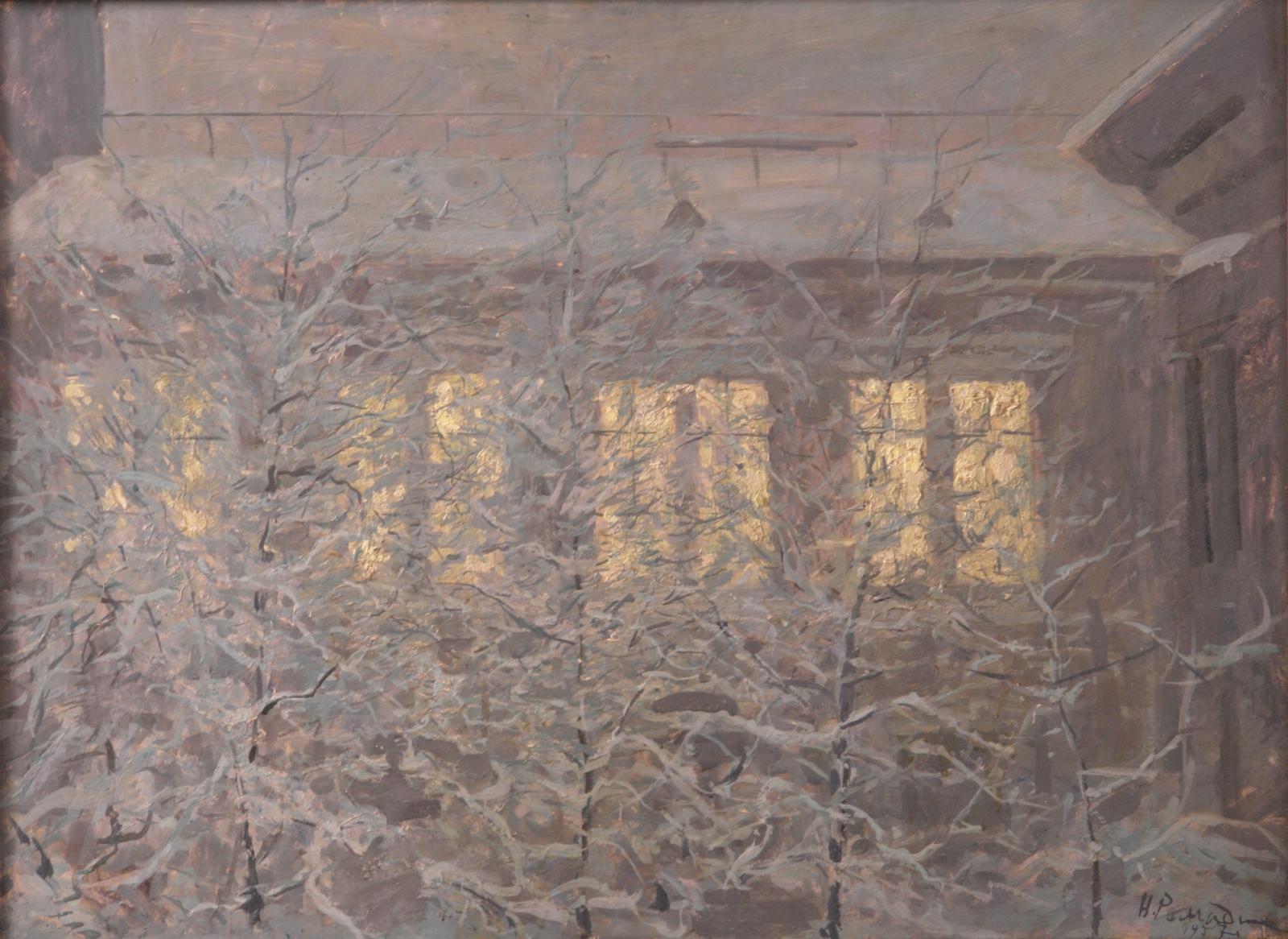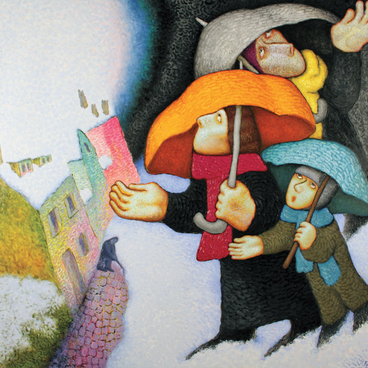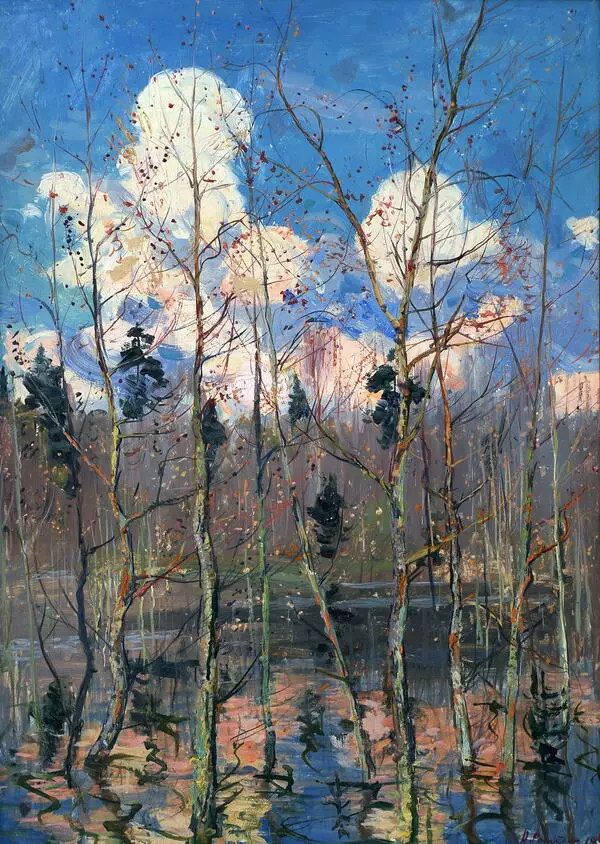Nikolay Mikhailovich Romadin (1903-1987) is an artist, a master of lyrical landscape, titular member of the Academy of Arts, People’s Artist of the USSR, a tutor.
The future artist was born on May 6 (19), 1903, in Samara into the family of a railway employee. In 1922, he was enrolled into Samara College of arts. After graduation in 1923, Nikolay Romadin became a student of VKHUTEMAS (Higher Art and Technical Studios) in Moscow. This training institution appeared in 1920, by way of joining the First and the Second State Liberal Art Studios (they, in their turn, were established based on Stroganov School of Arts and Industries and Moscow School of Arts, Sculpture and Architecture). Robert Falk and Pyotr Konchalovsky were his tutors. In 1930-s, Romadin worked mainly in the genre of historic revolutionary painting; later he started painting landscapes, which made him popular. In particular, the artist became well known for his landscapes of the war years, for example, his cycle Volga, the Russian River, for which he received the State Stalin Prize in 1946. For his work, Romadin was awarded the titles of the titular member of the Academy of Arts of the USSR (1967), the People’s Artist of the USSR (1971), as well as Order of Lenin and Order of the Red Banner of Labour.
Romadin was friends with Konstantin Paustovsky, the writer, who wrote an essay ‘Our Nature in the Work of Romadin’ in 1963.
Starting from 1929, Romadin was an active participant of various exhibitions: ‘Socialism Building in Soviet Art’ (1930–1931), Anti-Imperialistic Exhibition Dedicated to the International Red Day (1931), ‘15th Anniversary of Russian Red Army’ (1933) in Moscow, anniversary exhibition ‘RSFSR Artists after 15 Years’ in Leningrad and in Moscow (1932–1934), exhibition of Soviet art in Konigsberg (1932) and others. In 1940, he organised his personal exhibition in Moscow.
The artist created the exhibited painting Winter Sentiment in 1957. In 1961, the RSFSR Ministry of Culture granted this painting to Kaluga Museum. It is the author’s replication of the painting View over the Rembrandt Hall in the Hermitage created in 1955 and kept by the State Russian Museum in St. Petersburg. The painting from Kaluga Museum is special due to its bigger format. Nikolay Romadin chose to depict the Rembrandt Hall in the evening hours in the winter season. The Winter Sentiment is performed in grey, blue, lilac, yellow and pink colours – the favourites of N.M. Romadin. The artist used to say about his own work: “The landscape is not a mirror, it does not reflect, it expresses”.
Nikolay Romadin died on April 10, 1987; he is buried in Vagankovskoye cemetery in Moscow.
The future artist was born on May 6 (19), 1903, in Samara into the family of a railway employee. In 1922, he was enrolled into Samara College of arts. After graduation in 1923, Nikolay Romadin became a student of VKHUTEMAS (Higher Art and Technical Studios) in Moscow. This training institution appeared in 1920, by way of joining the First and the Second State Liberal Art Studios (they, in their turn, were established based on Stroganov School of Arts and Industries and Moscow School of Arts, Sculpture and Architecture). Robert Falk and Pyotr Konchalovsky were his tutors. In 1930-s, Romadin worked mainly in the genre of historic revolutionary painting; later he started painting landscapes, which made him popular. In particular, the artist became well known for his landscapes of the war years, for example, his cycle Volga, the Russian River, for which he received the State Stalin Prize in 1946. For his work, Romadin was awarded the titles of the titular member of the Academy of Arts of the USSR (1967), the People’s Artist of the USSR (1971), as well as Order of Lenin and Order of the Red Banner of Labour.
Romadin was friends with Konstantin Paustovsky, the writer, who wrote an essay ‘Our Nature in the Work of Romadin’ in 1963.
Starting from 1929, Romadin was an active participant of various exhibitions: ‘Socialism Building in Soviet Art’ (1930–1931), Anti-Imperialistic Exhibition Dedicated to the International Red Day (1931), ‘15th Anniversary of Russian Red Army’ (1933) in Moscow, anniversary exhibition ‘RSFSR Artists after 15 Years’ in Leningrad and in Moscow (1932–1934), exhibition of Soviet art in Konigsberg (1932) and others. In 1940, he organised his personal exhibition in Moscow.
The artist created the exhibited painting Winter Sentiment in 1957. In 1961, the RSFSR Ministry of Culture granted this painting to Kaluga Museum. It is the author’s replication of the painting View over the Rembrandt Hall in the Hermitage created in 1955 and kept by the State Russian Museum in St. Petersburg. The painting from Kaluga Museum is special due to its bigger format. Nikolay Romadin chose to depict the Rembrandt Hall in the evening hours in the winter season. The Winter Sentiment is performed in grey, blue, lilac, yellow and pink colours – the favourites of N.M. Romadin. The artist used to say about his own work: “The landscape is not a mirror, it does not reflect, it expresses”.
Nikolay Romadin died on April 10, 1987; he is buried in Vagankovskoye cemetery in Moscow.




